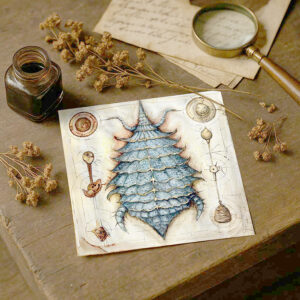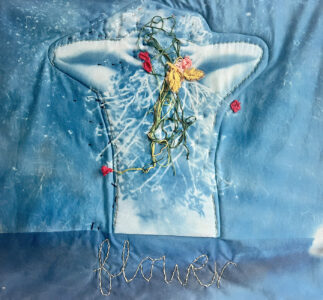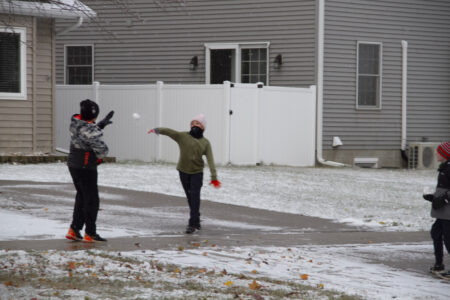‘The Wilding Hours’ on display at Besse Gallery
- “Terra Incognita” (mockup table) by Don Krumpos, an artist whose work will be on exhibit in Bay College’s Besse Gallery. (Courtesy photo)
- “Flowers” by Erin LaBonte, an artist whose work will be on exhibit in Bay College’s Besse Gallery. (Courtesy photo)

"Terra Incognita" (mockup table) by Don Krumpos, an artist whose work will be on exhibit in Bay College's Besse Gallery. (Courtesy photo)
ESCANABA – “The Wilding Hours,” an exhibition featuring artists Erin LaBonte and Don Krumpos, will be on display in the Besse Gallery on the Bay College Escanaba Campus.
A reception and artist talk will take place at 2 p.m. Thursday, Nov. 20, in the Besse Gallery. The gallery is free and open to the public.
Yonder is a brick-and-mortar storefront and creative space in Algoma, Wis., that Krumpos and LaBonte co-founded in 2019. Yonder is run by artists dedicated to enriching the regional and local art experience through mural arts, workshops, exhibition opportunities, puppetry performance and more, according to a news release. Through sculpture, ink, wood, found objects, and performance, artists explore symbols, myths and histories.
LaBonte received her bachelor of fine arts from the University of Wisconsin-Stevens Point and her master of fine arts from the Pennsylvania Academy of the Fine Arts in Philadelphia. She has participated in artistic residencies in Costa Rica and Argentina and has exhibited nationally and internationally.
LaBonte practices many artistic mediums in her own studio work. She is an advocate for bringing art to public spaces and for community engagement.

"Flowers" by Erin LaBonte, an artist whose work will be on exhibit in Bay College's Besse Gallery. (Courtesy photo)
LaBonte is dedicated to inspiring and educating young artists in their personal explorations. She served as associate professor of art at Silver Lake College in Manitowoc, Wis., for nine years, and is currently a middle and high school art teacher in Kewaunee, Wis.
“This body of work reflects my life–its cycles, changes, and quiet moments. It began one summer, lying in my garden, taking photographs. The next summer, I returned, laying cyanotype-soaked fabric to imprint memories of the year before. Now, this summer, I sit in the same garden preparing to exhibit the work,” LaBonte said in a news release.
“Working with fabric and embroidery felt instinctively feminine, rooted in tradition. My mother sewed the edges of each piece, her hands finishing what mine began–an intimate collaboration across generations,” she said.
As I’ve moved through womanhood, motherhood, and now middle age, my awareness of time and presence has deepened. I believe art is inherently political. Sharing female perspectives is not just personal — it’s a quiet resistance. This work is part of a larger act of collective world-building, where process and presence are both political and empowering,” LaBonte said.
Her husband, Krumpos, grew up on a century-old hobby farm in northeast Wisconsin cobbling together inventions from his father’s cast-iron machinery and developing a kinship for bric-a-brac and found objects. He is an art educator and makes work that embraces the spectacle of live performance and the participatory nature of the artmaking and viewing process.
He said of the creative process, “It began with walks — along limestone bluffs, through cedar groves, beside marshes stirred by cranes and wind. In those quiet, attentive hours, I walked without a map. The creatures in these watercolor studies are not imagined inventions. They are kin of fog and field, met with ritual, solitude, and the wild quiet of place. They are what remain when you walk long enough to fall out of ordinary time.”
“… This installation presents a fragment of that ongoing archive: a naturalist’s wagon, overgrown and half-abandoned, where drawings are pinned like field notes. The objects and images act as specimens in a kind of animist science — a tender, poetic taxonomy of what remains when land is listened to as alive,” Krumpos stated in the news release.
“My practice is shaped by bioregional animism, poetic ethnography and grief as method,” he said. “I draw not to categorize, but to keep memory company. Each image is a glyph in a larger, unfolding cosmology — one that resists enclosure, favors mystery, and insists on the presence of spirit in place.”
The Besse Center South Gallery is at 2001 N. Lincoln Road in Escanaba, at the entrance to the Learning Resource Center. This gallery houses the college’s permanent art collection, as well as exhibits of local and national artists.





